Terahertz technology is making breakthroughs in the areas of remote sensing, homeland security, and product inspection. Both CW and pulsed THz systems are beginning to play key roles in areas of inspection and sensing.
Various types of compact CW THz sources are being developed, such as Gunn diodes and Quantum Cascade lasers. However, making a convenient pulsed THz source has been a very formidable challenge. The front-end of pulsed terahertz systems requires a high performance, reliable, and practical femtosecond pulsed laser source. Typically, Ti:Sapphire lasers are used as the “engine” that powers pulsed THz systems. In order to transfer THz technology from the laboratory to usable systems in the field, there needs to be an alternative to Ti:Sapphire lasers, which present severe limitations due to their size, complexity, and need for water-cooling. Mode locked fiber lasers will serve this role, and enable developers to take the next step in making THz technology a practical solution for many real-world problems.
The FX-100 laser as a Ti:Sapphire replacement
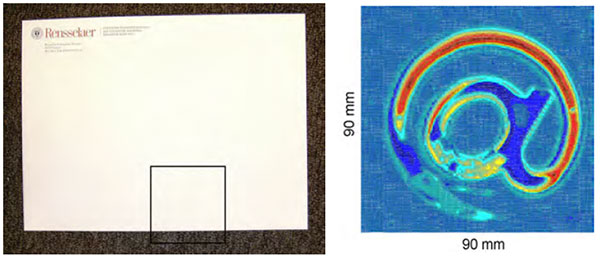
Figure 1: A demonstration of THz imagining using the FX-100 fiber laser. (a) Photo of an envelope with a letter opener inside. (b) THz image of the letter opener concealed inside the envelope. In this mostly plastic component, the metal blade is clearly distinguishable. (Image courtesy of X.-C. Zhang).
At RPI’s Center for Terahertz Research, Professor X.-C. Zhang and his research team demonstrated the utility of IMRA’s Femtolite F-100 (the predecessor of the current Femtolite FX products, shown on the next page) fiber laser as a replacement for Ti:Sapphire in THz systems. This type of laser can be used to perform THz time-domain spectroscopy of many materials and structures, including bio-agents and highly energetic materials.
With over 100 mW of average power, the FX-100 takes femtosecond fiber lasers into the realm of THz imaging, opening up a whole new range of applications.
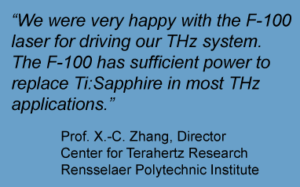
Test results have shown that the FX-100 has higher energy conversion efficiency from laser radiation to THz radiation than the Ti:Sapphire lasers that are typically used, due to optimized repetition rate and pulse width. With the same pump power, the FX-100 laser can generate stronger THz fields.
The biggest impact of these fiber lasers will be in commercial application areas that require a small footprint for THz equipment. Other key advantages of fiber laser systems are that they are easy to use and are air cooled. Since the power consumption is low, and there is no need to run chilled water, long-term tests can be run economically with 24/7 operation for weeks with no interruption.
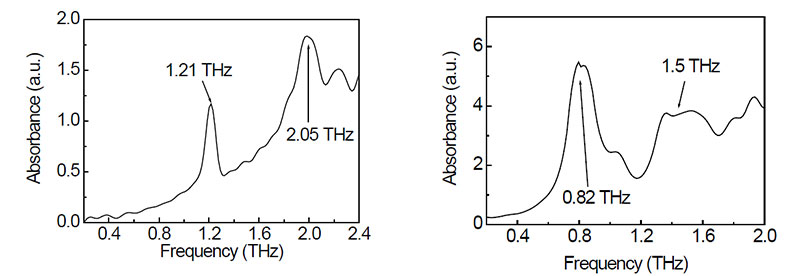
Figure 2: (right) Absorbance spectrum of Glutamic acid in the THz frequency region. Sample is a pellet with 26 mg Glutamic acid powder in 150 mg polyethylene powder. Glutamic acid is an indicator molecule for detection of anthrax.
(left) Absorbance spectrum of RDX explosive in the THz frequency region. Sample is a 0.8 mm tablet. There are multiple absorption peaks around 1.5 THz.
IMRA has recently added a new product with the same performance as the FX-100, but a much smaller footprint. The new FX-100i laser was unveiled at the Photonics West exhibition in January, 2011. The original sized package now offers > 150 mW (see details below).
With IMRA’s rugged, compact lasers, designed for industrial use, we can envision truly portable pulsed THz systems that can be used in environments and applications that were never possible before.
As the terahertz imaging application field matures, lightweight, turn-key fiber lasers like the FX-100 and FX-100i series will enable a new generation of compact and portable THz instruments. These systems will have an impact on sensing of bio-agents, explosives and security as well as on product inspection.
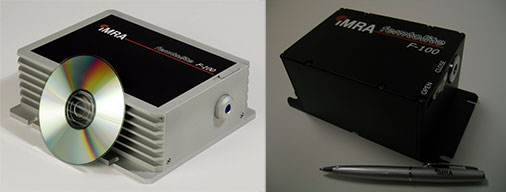
Left: Femtolite FX-150, Right: Femtolite FX-100i
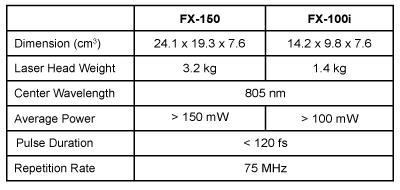
Femtolite FX Series Specifications
*This is an application note only. Please note that IMRA no longer manufactures the Femtolite FX-100i. For a comparable product please see the Femtolite F/G/H line.

